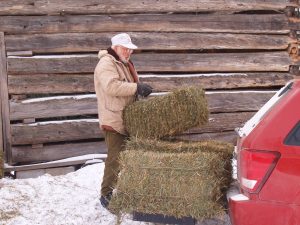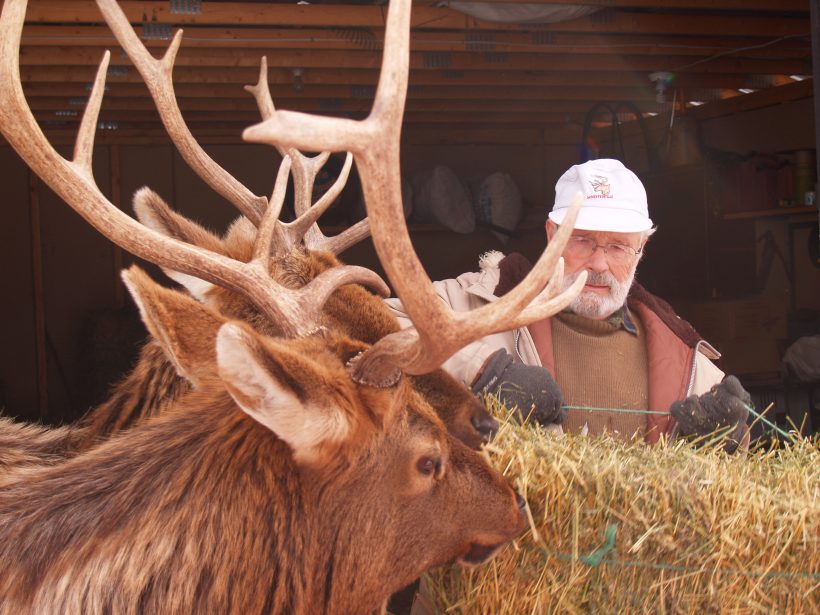PRINCE BILLY
Most people have a bird feeder or two in their yard and are quite content to enjoy a cup of tea while watching the Pine Grosbeak, Blue Jays, and Chickadees flocking to the feed. The seed, suet, corn and other foodstuffs provide relatively inexpensive entertainment and education. Then there is Joe Neuhold, now known as “The Elkman”. As I pulled into his yard early in 2002 I can’t recall seeing any feeders for the feathered sort at his digs but that doesn’t mean there were none. It’s just that when I pulled into Joe’s drive all I could see were deer so I may have overlooked some detail. And, speaking of feed, Joe was spending $1000.00 alone on 350 bales of second cut alfalfa, not to mention the added expense of bags of corn (“They’re not that crazy about corn”), oats, block salt and apples.
The previous day had been a perfect postcard bluebird day with not a cloud to dot the sunny sky. “There were 13 elk and 14 deer here yesterday,” Joe told me. By contrast this day was overcast, snowy and stormy. As there were no elk present – and as I was there to see elk. I was hoping this wouldn’t be another case of “you should have been here yesterday.”
Joe and his wife Edith bought 100 acres, the former Lott homestead, in 1970 and they built a chalet styled retreat on it. “If we saw a deer track then we could eat it,” said Joe, implying that they were rather scarce. A change in Ontario’s hunting regulations, commonly called the Doe Law, made it such that a hunter could not take a doe during the deer season without an antlerless tag also referred to as a doe tag. Many credit this with the rejuvenation of the deer herd. Joe recalled, in the course of his work, gathering up bags of perfectly good salt that his customers were going to throw out simply because they had a tear in them and leaked salt everywhere. He would transport the salt to their retreat on the Hartsmere Road and leave it for the deer. Returning for the weekend they could see the deer tracks where the salt had been consumed. “We were so excited,” said Joe. He was also so excited that they had been able to purchase the acreage. This would have been a farm in his native Austria and he never would have been able to afford it there.
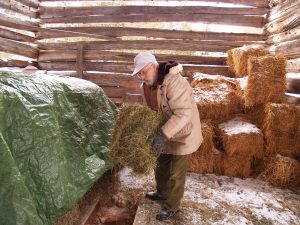
As one deer approached our viewing area Joe identified her as “Pinky.” One look at her nose told us why. “She’s been coming for at least 17 years,” he said. “I think she is beginning to slow down. This is the first year that she didn’t have twin fawns.” Joe said that Pinky was starting to go deaf as she wouldn’t hear him coming when he went out to feed the deer. When she sees the other deer moving off she’ll look up. “I usually cal ‘Pinky, Pinky’ so she won’t be startled.” But when it came to the elk no one had any inkling in 1970 that someday elk would once again be roaming these backwoods. Inside his chalet, Joe pulled out a photo album and showed us some magnificent elk – from the time when he had traveled to Jasper.
“Did you ever imagine you would ever see elk here in Ontario?” I asked.
“No,” he replied, “especially when you hear that it costs about $10,000.00 an animal.”
The feeder was located where the Lotts used to grow their corn, not far from where Durl Lott, as a boy of 14 had dug a well. “Uncle Simon Bronson, an itinerant preacher, had a Hazel switch and he witched for water,” said Lott, now a retired teacher. “That’s where I dug and that’s where the water was,” he added.
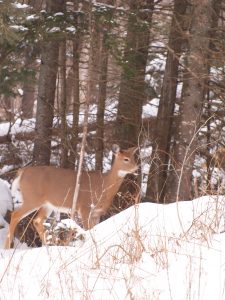
“Deer are sloppy eaters,” continued Neuhold, “whereas the elk eat up everything. They’re like a vacuum cleaner.”
Since there were no elk to see Joe suggested that we go for a drive in search of his favorite elk that he had nicknamed Prince Billy. Joe quartered some apples and threw some hay into the back of his van before we set out. “Usually I leave and when I return the elk are at the feeder. It’s like they are watching.”
As we passed a neighbor (several miles away, for this is in the country) shoveling his driveway our peripheral vision detected Prince Billy standing close behind him as if supervising the job. Most people will have their pet poach keeping them company but in this neck of the woods it’s likely to be Prince Billy.
“I have to watch him,” said the neighbour. “Billy likes to butt now and then. Earlier he tried to get into the house.”
“He’s been in mine,” admitted Joe, smiling ear to ear. And so we hand fed Billy some apple quarters to prevent any accidental choking and then we dropped the hay in the nearby bush for him to graze.
Billy wasn’t always in the robust condition that we were seeing. “One time he stayed in the same position in my yard for 18 hours without moving,” said Joe. “I took him some food and water and I called the Ministry of Natural Resources (MNR). They told me to watch, wait and see what happens.” Under Joe’s watchful care Billy started to eat and soon he was mingling with the deer. “He loves the deer. You’ll often find him in the middle of them. Just before deer season he took off.”
As he had predicted, when we returned to Joe’s, the elk had arrived and were at the feeder, styled after the Austrian type with which Joe was so familiar. Concerned about elk being shot for deer Joe had left some photos with the MNR in Peterboro and suggested that they might include them in the hunting regulations to help hunters properly identify them.
For two years I tried to catch a glimpse of the magnificent elk known as the Hartsmere bull. It became a source of humour. I would wait for hours watching the deer and elk but the bull never showed. Finally I would have to leave and no sooner would I arrive home when there would be a message from Joe announcing that as soon as I got to the top of the hill and out of sight the Hartsmere bull showed up. Joe always found that funny. It was as if the bull was waiting and watching for me to leave. Joe and I even tried driving off and returning but it never worked.
And so, one day as I sat down to lunch the phone rang. It was Joe. The bull was “here.” Joe had called earlier in the morning to tell me that the bull had been at Joe’s the previous day and perhaps he would return. With no further inspiration I was on my way.
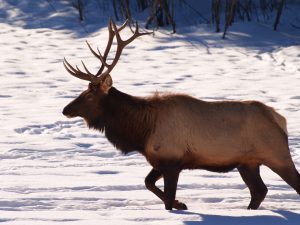
The weather office was forecasting a winter storm and I supposed that the deer and elk were stocking up so they could ride out the storm while chewing their cud. I could only hope that I wasn’t too late and that upon my arrival I wouldn’t spook them. It was a warm March day with lots of sunshine and a high of 5 degrees Celsius – an oasis of warmth in the midst of a recent deep freeze. It takes such extremely cold weather to fully appreciate the warmth of the sun that can be so invigorating.
Although Joe’s photos of the Hartsmere Bull were impressive nothing could compare to the reality of seeing him in all his living magnificence. The best camera lens fares only adequately against the combination of the mind and eye. And, as an added bonus, another young bull in the spike horn stage came along with more elk. In total there were 14 elk and several deer. And so as Joe and I sat in the comfort of his kitchen enjoying a hot mug of his special tea and savoring the experience I could only marvel at the Creator’s creation and silently hum “Oh give me a home where the buffalo roam and I’ll show you a messy house.”
Billy never made it to adulthood. Joe discovered his remains near the chalet. Researchers think Billy may have succumbed to brainworm. During 2000 to 2005, 17 of 29 (59%) elk that died near Bancroft were infected with brainworm. This was based on post mortem studies that showed brain lesions. “The brainworm parasite dramatically affects the behavior of elk,” said Dr. Rick Rosatte, Senior Research Scientist at the Ontario Ministry of Natural Resources (OMNR). He said such signs included a circling behavior, tameness (as in acting friendly), head-drooping, abnormal antler growth and, in general, poor conditioning.
